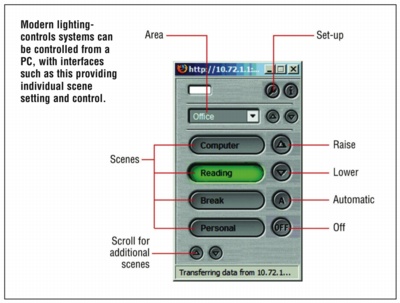Lighting the way through recovery

James Callcut looks at how the recession has hastened the specification of comprehensive lighting control systems.
A major driver behind the implementation of Building Regulations and Part L in particular was to make an impact on the carbon footprints of commercial buildings. However, whereas the requirements may have largely been seen as a maximum rather than minimum standard, the impact of the recession and the need to look at whole-life cost savings has led to a marked rise in the adoption of intelligent, energy-saving lighting control.
This is not a poor reflection on the effectiveness of regulation or a suggestion that it does not go far enough. It is simply the case that with budgets being squeezed, the benefits of building-wide control of lighting — which often accounts for over 25% of a commercial building’s energy use — are much plainer to see. Reducing that energy usage affects the bottom line, and the comprehensive nature of today’s networked lighting-control systems allows specifiers to convince an investor of the multiple benefits of the system much more easily.
Reducing that potential 25% consumption figure is readily achievable, and even simple measures can make a big difference; simple PIR-based absence recognition or scheduled switching both make an impact. However, an intelligent, managed control system, fully integrated to offer even a certain amount of personal control delivers both energy savings (much greater than regulations sought to achieve) and a more pleasant working environment.
The basic principles of lighting control are to make maximum use of daylight and avoid unnecessary lighting during times when spaces are unoccupied.
Devices such as switches, time clocks, presence detection and absence recognition, as well as photocells can turn luminaires on and off. However, if a more advanced solution is required, it could also include high frequency dimmable control gear linked to photocells to provide constant illumination and daylight linking, reacting to the external conditions — a hugely important factor in the efficient control of lighting.
Dynamic daylight luminaires allow reflection or enhancement of natural light levels. Going further than simply replicating the conditions of the day, this sort of set-up can mimic natural daylight and create the appearance of a bright Summer’s day when, in reality, the natural light is dull and grey.
On a personal (or, more to the point, personnel) level, studies have shown that creating a natural environment helps increase productivity, reduce worker fatigue and increase staff comfort. This is why these lighting systems have become so popular for office lighting, as it moves lighting control from the macro to the micro. Having instant control over the lighting makes it possible to adjust individual lighting levels to create a much more relaxed working environment.

In terms of complexity, the detection element is achievable with a single sensor, allowing the daylight detection function to work with the geometry of your building and adjust the output of every luminaire to maintain the desired working light level. Part of the networked system, daylight detection is often fully versatile, being compatible with both the latest wireless controls, as well as standard wall switches.
Crucially, this goal is achievable for both new build and refurbishment developments. Through the use of software based control systems that use standard TCP/IP and DALI, complete access is provided to building systems from a single interface. This enables individual building users to control their own environment via a PC pop-up or wireless control, as well as the system making use of the existing data network and manual control switches.
This is an important aspect of the networked product, making it much more accessible because, whether you have an existing control system in place or are simply using standard switches and luminaires, the diversity of these systems means that there is a control mechanism for a variety of situations. This allows you to benefit from the energy and cost efficiency savings without necessarily having to invest in a full package of additional controls and make expensive luminaire upgrades — particularly relevant at the moment, with an increase in refurbishment projects, due to the halt in commercial construction.
Where the full spectrum of controls is desired, fully customisable LCD control panels showing entire room overviews can be combined with multiple interfaces but, in summary, simply going beyond Building Regulations and providing maximum cost and energy efficiency has become a priority for office lighting design. An integrated control system, carefully designed and commissioned to fit exactly with the characteristics of a building and to be completely user friendly is the most effective way of achieving this commercial efficiency.
James Callcut is lighting controls product manager with Ridi.
www.ridi-lighting.co.uk








